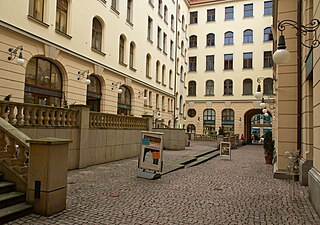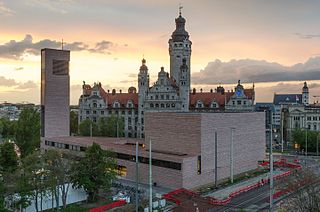The arcade galleries in Leipzig developed in connection with the emergence of inner-city exhibition centers of the Leipziger Messe at the turn of the 20th century [1] and are often based on old passageways. But the tradition of building passages has also been maintained in more recent times. The Leipzig passages and courtyards thus form a unique architectural quality in Leipzig-Mitte and run through the old city center parallel to the network of existing streets and alleys like a second, private path system that is only reserved for pedestrians.
Contents
The list includes all the usable arcade galleries.
| Picture | Name | Address and access | Length and area | Built or remodeled |
|---|---|---|---|---|
 | Barthels Hof | Hainstrasse 1 ( 51°20′28″N12°22′24″E / 51.341158°N 12.373400°E ) Markt 8, Barfußgäßchen, Webers Hof | 122 m (400.3 ft) 876 m2 (9,429.2 sq ft) including Webers Hof | 1747–1750 1870/1871 portal to the Markt 1997 fundamental renovation |
 | Bauwens-Haus | Burgplatz 2 ( 51°20′15″N12°22′22″E / 51.337452°N 12.372867°E ) Ratsfreischulstraße, Markgrafenstraße | 46 m (150.9 ft) 589 m2 (6,339.9 sq ft) | 1991–1994 new building |
 | Blauer Hecht | Nikolaistraße 39–45 ( 51°20′32″N12°22′40″E / 51.342145°N 12.377746°E ) Nikolaistraße, Reichsstraße | 37 m (121.4 ft) 146 m2 (1,571.5 sq ft) | 1911/1912 |
 | Brühl-Arkade | Brühl 33 / Richard-Wagner-Straße 9 ( 51°20′35″N12°22′39″E / 51.343055°N 12.377386°E ) Brühl, Richard-Wagner-Straße | 86 m (282.2 ft) 477 m2 (5,134.4 sq ft) | 1998 new building |
 | Burgplatz-Passage | Burgplatz 5, Markgrafenstraße, Burgstraße ( 51°20′14″N12°22′25″E / 51.337129°N 12.373582°E ) | 28 m (91.9 ft) extension of the Petersbogen | 2017–2020 new building |
 | Dresdner Hof | Neumarkt 21–27 ( 51°20′16″N12°22′37″E / 51.337825°N 12.376971°E ) Kupfergasse, Neumarkt, Magazingasse | 80 m (262.5 ft) 624 m2 (6,716.7 sq ft) | 1912/1913 exhibition center 1998–2000 renovation |
 | Der Große Joachimsthal | Hainstraße 10, Katharinenstraße 13 ( 51°20′31″N12°22′27″E / 51.342004°N 12.374048°E ) Hainstraße, Katharinenstraße | 49 m (160.8 ft) 215 m2 (2,314.2 sq ft) | 1896–1906 2000 Hainstraße side renovated |
 | Hansa-Haus | Grimmaische Straße 13–15 ( 51°20′24″N12°22′39″E / 51.340072°N 12.377469°E ) Grimmaische Strasse, Passage Specks Hof | 136 m (446.2 ft) 709 m2 (7,631.6 sq ft) including passage Specks Hof | 1904–1906 1993–1997 new building |
 | Handwerkerpassage | Markt 10, Klostergasse 16 ( 51°20′26″N12°22′25″E / 51.340656°N 12.373622°E ) Markt, Klostergasse, Barfußgäßchen | 76 m (249.3 ft) 309 m2 (3,326.0 sq ft) | 1845–1846 GDR 1987–1989, front building renovated 1997–1998 |
 | Jägerhof-Passage | Hainstraße 17–19, Große Fleischergasse 11–13 ( 51°20′32″N12°22′22″E / 51.342105°N 12.372761°E ) Hainstraße, Große Fleischergasse | 123 m (403.5 ft) 1,055 m2 (11,355.9 sq ft) | 1911–1914 Hainstraße 1919/1920 Gr. Fleischergasse 1998 renovated |
 | King Albert House | Markt 9, Barfußgäßchen 2–8 ( 51°20′28″N12°22′26″E / 51.341009°N 12.373832°E ) Markt, Barfußgäßchen | 71 m (232.9 ft) 244 m2 (2,626.4 sq ft) | 1913 renovated |
 | Königshaus-Passage | Markt 17, Petersstrasse 13 ( 51°20′22″N12°22′30″E / 51.339436°N 12.375111°E ) Markt, Petersstraße, Mädlerpassage, Messehofpassage | 121 m (397.0 ft) 743 m2 (7,997.6 sq ft) | 1932 arcade passage 1961–1963 access to Messehofpassage 2004–2006 renovation |
 | Kretschmanns Hof | Hainstraße 14, Katharinenstraße 17 ( 51°20′33″N12°22′28″E / 51.342393°N 12.374411°E ) Hainstraße, Katharinenstraße | 89 m (292.0 ft) 479 m2 (5,155.9 sq ft) | 1912–1914 2009–2010 renovation |
 | Mädler Arcade Gallery (Mädlerpassage) | Grimmaische Straße 2–4, Neumarkt 14 ( 51°20′21″N12°22′32″E / 51.339081°N 12.375450°E ) Grimmaische Straße, Neumarkt, Königshaus-Passage | 140 m (459.3 ft) 840 m2 (9,041.7 sq ft) | 1912–1914 1995–1997 renovation |
 | Marktgalerie | Markt 11, 12, Klostergasse 12 ( 51°20′25″N12°22′25″E / 51.340324°N 12.373606°E ) Markt, Klostergasse | 80 m (262.5 ft) 624 m2 (6,716.7 sq ft) | 2002–2005 renovation |
 | Messehofpassage | Petersstraße 15, Neumarkt 16–18 ( 51°20′20″N12°22′32″E / 51.338819°N 12.375525°E ) Petersstraße, Neumarkt, Preußergäßchen, Königshaus-Passage | 140 m (459.3 ft) 870 m2 (9,364.6 sq ft) | 1949/1950 2004–2006 renovation |
 | Oelßners Hof | Nikolaistraße 20–26, Ritterstraße 23–29 ( 51°20′30″N12°22′44″E / 51.341785°N 12.378822°E ) Nikolaistraße, Ritterstraße | 1907/1908 2012–2015 renovation | |
 | Petersbogen | Petersstraße 36–44, Burgstraße 27 ( 51°20′15″N12°22′27″E / 51.337577°N 12.374152°E ) Petersstraße, Burgstraße, Schloßgasse | 116 m (380.6 ft) 1,557 m2 (16,759.4 sq ft) | 1999–2001 new building |
 | Specks Hof | Reichsstraße 4, Schuhmachergäßchen 2, Nikolaistraße 3–9 ( 51°20′25″N12°22′39″E / 51.340313°N 12.3774570°E ) Reichsstraße, Schuhmachergäßchen, Nikolaistraße, Hansa-Haus | 136 m (446.2 ft) 709 m2 (7,631.6 sq ft) including Hansa-Haus | 1908/1909, 1911, 1928/1929 construction in stages 1993–1997 renovation |
 | Städtisches Kaufhaus | Neumarkt 9–19, Universitätsstraße 16 ( 51°20′19″N12°22′37″E / 51.338492°N 12.376978°E ) Neumarkt, Universitätsstraße, Gewandgäßchen, Kupfergasse | 144 m (472.4 ft) 690 m2 (7,427.1 sq ft) | 1893–1901 1993–1994 renovation |
 | Steibs Hof/ Dussmann-Passage | Nikolaistraße 28–32, Brühl 64–66 ( 51°20′31″N12°22′43″E / 51.342038°N 12.378504°E ) Nikolaistraße, Brühl | 83 m (272.3 ft) 412 m2 (4,434.7 sq ft) | 1906/1907 1994–1996 renovation |
 | Stentzlers Hof | Petersstraße 39–41 ( 51°20′31″N12°22′43″E / 51.342038°N 12.378504°E ) Petersstraße, Peterskirchhof. | 1914–1916 1994/1995 renovation | |
 | Strohsack-Passage | Nikolaistraße 10 / Ritterstraße 7 ( 51°20′27″N12°22′43″E / 51.340904°N 12.378522°E ) Nikolaistraße, Ritterstraße | 88 m (288.7 ft) 6,050 m2 (65,121.7 sq ft) | 1995–1997 new building |
 | Theaterpassage | Goethestraße 2, Ritterstraße 6 ( 51°20′24″N12°22′47″E / 51.339958°N 12.379781°E ) Goethestraße, Ritterstraße | 43 m (141.1 ft) 165 m2 (1,776.0 sq ft) | 1927/1928 |
 | Webers Hof | Hainstraße 3 ( 51°20′29″N12°22′26″E / 51.341317°N 12.373783°E ) Hainstraße, Barthels Hof | 122 m (400.3 ft) 876 m2 (9,429.2 sq ft) including Barthels Hof | 1662 1845–47, 1872 remodeled 1995–1997 renovation, restoration to the structural condition of 1662 |
















